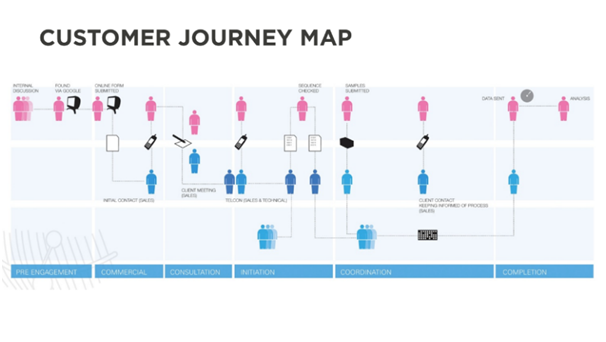Have you ever thought about why many websites, digital products and other online services fail to strike a chord with target audiences in spite of being based on great ideas? This primarily is because of the web developer’s lack of direct and cohesive understanding of the customer experience, end to end.
You can ensure that your digital services or products meet or even exceed the needs of your online customers by creating a customer journey map that deals with all steps of interaction between the customers and your digital products. This blog post presents all the information essential for this strategy for ensuring a great customer experience.
Benefits of Customer Journey Map
A customer journey map is a planning project of a considerable magnitude and requires a significant level of commitment by a business. However, there are a number of benefits that your business can derive from it, which include:
- Learning more about each end user segment – Organizations of all sizes stand to benefit from the insights and advanced segmentation related to target audiences that can be achieved through the implementation of this tool.
- Creation of a clear improvement path – A customer journey map ensures a clear understanding of the existing customer experience and the best ways to improve it for everyone in the organization. It is usually a one-page visual and is quite handy.
- Comprehension of how key emotions and decisions interact – How customers go down the path of conversion is impacted by their emotions. So, a customer journey map can help to highlight critical motives and discover connections with trends and audience actions.
- Making obscure touch points visible – Previously obscure touch points are often brought to the fore by a customer journey map. These include points of interaction and issues that may not have been very apparent before.
- Discovering the user’s perspective of the process – A customer journey map encourages a wider perspective for the whole team, besides large-scale goals. This prevents the development team from having a narrow view of a digital product, which may adversely affect its efficacy.
These benefits make it obvious that mapping out the customer journey in some form or the other makes a lot of sense for all companies.
Outlining a Customer Journey Map
Before we go on to a customer journey map’s creation, let’s go over the basics of how exactly the planning tool functions.
A customer journey map reviews, thoroughly and completely, the end to end customer experience across several touch points and channels. Every critical step, right from the discovery of your app or website to engagement and, ultimately, conversion or purchase, is focused on.
Further, the customer journey map also enables you to identify significant points of interaction between your business and customers. You can analyze all these touch points to understand the end user’s concerns, feelings and motivations during distinctive interactions with your service or product.
Creating a Customer Journey Map
First of all, you have to collect information on the essential components of a customer journey map. Then, you have to follow a few iterative steps to develop and refine the map.
The essential components of a customer journey map include:
- Emotion – This covers feedback regarding happiness, anxiety, frustration, etc., from your audience.
- Personas – These are fictitious characters that represent the pain points, needs, expectations, goals, feelings and thoughts of your target audience segments.
- Touch points – are the consumer interactions and actions relevant for your organization.
- Channels – These include the websites, call centers, apps and other channels through which the touch point interactions happen.
- Phases – include stages such as discovery, decision, buying, renewal, etc., which cover the customer experience during the relationship with your brand.
When you have collected information regarding the above components, it’s possible to create a customer journey map. The process includes the following steps:
- Reviewing the goals – The goals that you expect to achieve through a customer journey map can be both product-centric and brand-wide.
- Research – You require relevant consumer data, both quantitative and qualitative, for making good decisions and getting accurate insights regarding the customer.
- Mapping empathy – A basic outline of the profiles of your customers and how these profiles interact with your brand in various scenarios helps create an empathy map. This gives you a sense of the customer experience and serves as a foundation for your customer journey map.
- Outlining the journey – You have to create a representation that is relevant for your brand and customers. This comprises the touch points, timeline, emotions, channels, etc., and brings together all the ideas and information.
- Refinement and digitization – Ensure that everyone is working with accurate information and is on the same page, while creating a strong visual which is shareable with your digital product developers as well as other in-house departments.
- Use and share – Utilize the insights gained for various channels and platforms as you improve and enhance your digital services or products, among other digital assets.
How a Customer Journey Map Has a Quantifiable Impact on Customer Engagement
You stand to gain from greater in-house efficiency, besides greater customer engagement, when you develop a customer journey map. For instance, retail businesses stand to gain the following when they follow this approach:
- New ways of brand differentiation – You are not only able to meet your target audience’s needs but also find newer ways to differentiate your brand from the competition, based on the in-depth understanding of customer experience.
- Greater internal co-ordination –Your business process becomes more efficient and the co-operation between departments increases, when you create a customer journey map, regardless of the size of your organization.
More operational efficiency – Unforeseen expenditure can increase when you attempt to deliver new services without focusing on customer needs. So, creating a customer journey map helps reduce uncertainty and enables you to make better operational choices.
Conclusion
An accurate and comprehensive customer journey map can be immensely useful, even as creating it can be quite complex. Your business has to be highly committed to the process, from collecting information regarding pain points and ways of interaction with the target audience to considering the emotional factors that affect customer decisions.
If you can meet the challenges and utilize the information provided here well, you can craft a customer journey map accurately representing the path to conversion and highlighting opportunities for optimization.
Do you require help for creating a digital solution for improved customer engagement? Contact us now for a free consultation.







Leave A Comment